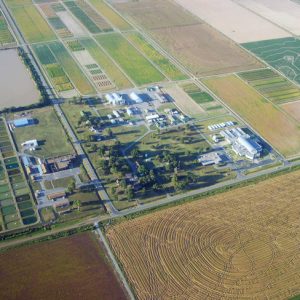calsfoundation@cals.org
University of Arkansas Rice Research and Extension Center
The University of Arkansas Rice Research and Extension Center (RREC), one of five research and extension centers in the University of Arkansas System’s statewide Division of Agriculture, is one of the best known and oldest rice research centers in the world. Arkansas produces almost half the rice grown in the United States, and the center has played a vital role in the success of the Arkansas rice industry.
RREC is located nine miles east of Stuttgart (Arkansas County) on Highway 130. Originally called the Rice Branch Station, it was authorized by the Arkansas General Assembly in 1923, and work commenced on it in December 1926. The University of Arkansas (UA) in Fayetteville (Washington County) made an earlier attempt at establishing a Rice Branch Station at Lonoke (Lonoke County) in 1902, but this facility closed for lack of funds. The initial property for the new Rice Branch Station at Stuttgart was 160 acres purchased from Sam Taggart. Part of the property had been in rice production since 1908, making it one of the oldest rice farms in Arkansas. Rice farming was generating a lot of interest in the Stuttgart area at that time, and influential members of the community, particularly B. E. Chaney and Charles Spicer, pushed hard for the creation of the station. Five subsequent land purchases brought the total acreage to nearly 1,000 acres.
Rice production in Arkansas became established around the early part of the twentieth century. The Grand Prairie, lying between the White and Arkansas rivers in southeast Arkansas, was particularly well suited to rice cultivation. As a native prairie, it was covered primarily by grasses and other herbaceous plants. Fire frequently burned the accumulated vegetation, keeping much of the land free of trees. The soil that supported this landscape had a “hardpan,” a layer of nearly impervious clay-like soil about six inches under the surface. This hardpan prevented water from percolating through the soil, a trait that made it ideal for flooded rice cultivation. This, coupled with ample available water, led to the development of the Arkansas rice industry. Today, Arkansas has about one and a half million acres in rice production.
After the initial farmers’ experiments and successes at growing rice, it was obvious that research was needed on many production issues. The Rice Branch Station, which was renamed the Rice Research and Extension Center in 1981, focused on addressing those issues. The most important research topic was the development of rice varieties adapted to the regional environment. Initially, varietal development was undertaken by a U.S. Department of Agriculture (USDA) scientist posted at the center, Dr. C. Roy Adair. Varieties were developed through conventional hybridization and selection as well as screening newly acquired varieties imported from around the world. Over thirty rice varieties have been developed at the center, including Zenith, Starbonnet, Newbonnet, and Wells. These varieties have been grown not only in Arkansas but also in other rice-producing states (Louisiana, Mississippi, Missouri, Florida, and Texas). Research on other areas of production include soil fertility, irrigation, plant physiology, entomology, plant pathology, and various aspects of crop, soil, and water management.
Six resident faculty and about forty-six support employees work at RREC. The complex contains two forty-acre reservoirs, greenhouses, laboratories, and seed-processing facilities in addition to research fields. A new laboratory facility will be completed by 2009. The total monetary value of the research at RREC is difficult to calculate, but it certainly is in the millions of dollars per year; hence it is a valuable resource to the state. Perhaps the greatest contribution the center has made has been the development of well-adapted, highly productive rice varieties.
Given that rice feeds more people in the world than any other food, the importance of RREC research transcends the borders of Arkansas. The center’s varieties are incorporated into many rice-breeding programs around the world. Many of the management practices developed at the center are employed by rice growers worldwide. The center also plays a vital role in training students and visiting researchers from around Arkansas, other states, and many foreign countries.
Ground was broken in Harrisburg (Poinsett County) in May 2023 for the Northeast Rice Research and Extension Center, owned and operated by the UA System Division of Agriculture, which will conduct research to serve the rice growers of northeastern Arkansas.
For additional information:
Spicer, J. M. Beginnings of the Rice Industry in Arkansas. N.p.: Arkansas Rice Promotion Association, 1964.
Christopher W. Deren
University of Arkansas Rice Research and Extension Center
 University of Arkansas Rice Research and Extension Center
University of Arkansas Rice Research and Extension Center 




Comments
No comments on this entry yet.